Intel Woodcrest: the Birth of a New King
by Jason Clark & Ross Whitehead on July 13, 2006 12:05 AM EST- Posted in
- IT Computing
Architecture Summary
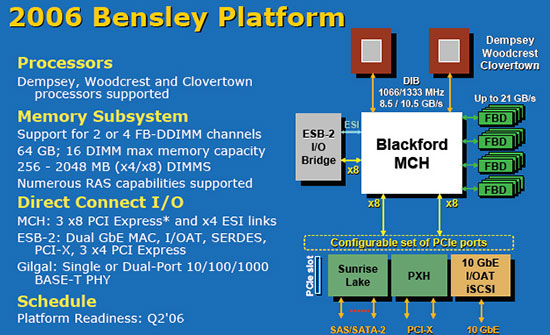
Woodcrest's home is a newer revision of the Bensley platform than what Dempsey launched with, which means that it's a drop-in part for newer Bensley based systems. If all goes to plan Clovertown (Quad-Core Xeon) should be a drop-in upgrade as well (depending on the system vendor). As we discussed in our Dempsey article, the Bensley platform features FB-DIMM with a peak bandwidth of 21GB/sec, SAS/SATA support and 1066/1333MHz FSB.
Woodcrest Highlights:
Shared 4MB L2 "Smart Cache"
Dempsey based processors had a separate 2MB L2 cache for each core, but Woodcrest has 4MB of L2 Cache shared between both cores. Due to the fact that the cores share a single cache, there is no data replication like there is with separate L2 caches; this results in more efficient data-sharing between cores. The shared cache also helps with mismatched loads: when one core is consistently using more cache than the other core, the CPU can allocate more L2 cache to that core. Both of these techniques are illustrated below.
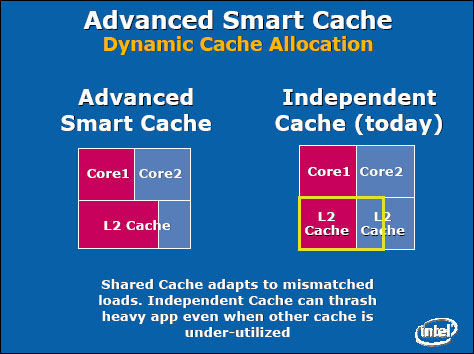
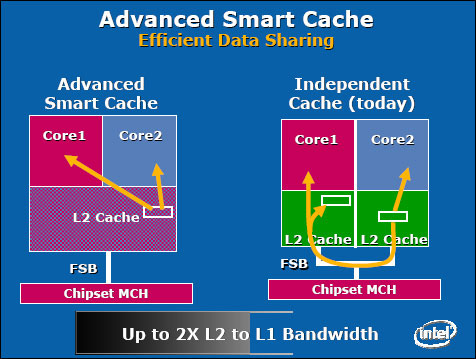
Wide Dynamic Execution Enhancements
With the Intel Core micro-architecture, every execution core is 33% wider than previous generations, allowing each core to fetch, dispatch, execute and retire up to four full instructions simultaneously. The Opteron - as well as all previous NetBurst Xeon processors - can only handle 3 at a time.
Macro Fusion
Macro-fusion combines certain common x86 instructions into a single instruction for execution. Without Macro-fusion four instructions at a time are fetched from the queue and each instruction gets decoded into separate micro-ops. With Macro Fusion, 5 instructions can be fetched at a time, and if a fusable pair is present it can be sent to a single decoder. A single micro-op can then represent two regular x86 instructions.
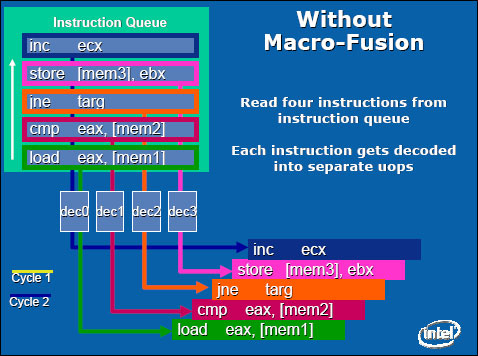
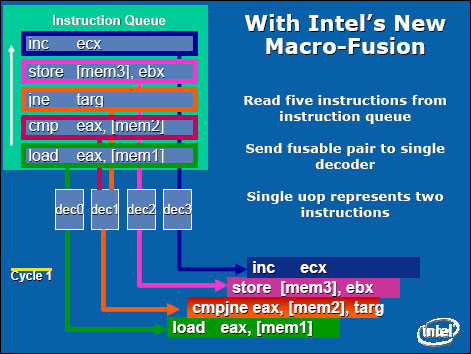
Beyond 2 Sockets, is Intel's FSB still an Achilles Heel?
As we've seen in past benchmarks, the front side bus has been a thorn in Intel's side, especially in the quad socket systems. Whether or not the new architectural changes that Intel has made with Woodcrest will alleviate enough of that pressure to overpower the scalability of Opteron in four socket configurations is unknown at this point. Intel is quite confident that with the shared cache and its dual independent FSB running at 1333MHz that bus bandwidth is not a concern, however at some point the bus bottleneck will be a problem. One of Intel's architects has however stated that an integrated memory controller is possible, which Intel has already shown us a demo of.

Woodcrest's home is a newer revision of the Bensley platform than what Dempsey launched with, which means that it's a drop-in part for newer Bensley based systems. If all goes to plan Clovertown (Quad-Core Xeon) should be a drop-in upgrade as well (depending on the system vendor). As we discussed in our Dempsey article, the Bensley platform features FB-DIMM with a peak bandwidth of 21GB/sec, SAS/SATA support and 1066/1333MHz FSB.
Woodcrest Highlights:
Shared 4MB L2 "Smart Cache"
Dempsey based processors had a separate 2MB L2 cache for each core, but Woodcrest has 4MB of L2 Cache shared between both cores. Due to the fact that the cores share a single cache, there is no data replication like there is with separate L2 caches; this results in more efficient data-sharing between cores. The shared cache also helps with mismatched loads: when one core is consistently using more cache than the other core, the CPU can allocate more L2 cache to that core. Both of these techniques are illustrated below.


Wide Dynamic Execution Enhancements
With the Intel Core micro-architecture, every execution core is 33% wider than previous generations, allowing each core to fetch, dispatch, execute and retire up to four full instructions simultaneously. The Opteron - as well as all previous NetBurst Xeon processors - can only handle 3 at a time.
Macro Fusion
Macro-fusion combines certain common x86 instructions into a single instruction for execution. Without Macro-fusion four instructions at a time are fetched from the queue and each instruction gets decoded into separate micro-ops. With Macro Fusion, 5 instructions can be fetched at a time, and if a fusable pair is present it can be sent to a single decoder. A single micro-op can then represent two regular x86 instructions.


Beyond 2 Sockets, is Intel's FSB still an Achilles Heel?
As we've seen in past benchmarks, the front side bus has been a thorn in Intel's side, especially in the quad socket systems. Whether or not the new architectural changes that Intel has made with Woodcrest will alleviate enough of that pressure to overpower the scalability of Opteron in four socket configurations is unknown at this point. Intel is quite confident that with the shared cache and its dual independent FSB running at 1333MHz that bus bandwidth is not a concern, however at some point the bus bottleneck will be a problem. One of Intel's architects has however stated that an integrated memory controller is possible, which Intel has already shown us a demo of.










59 Comments
View All Comments
Viditor - Thursday, July 13, 2006 - link
Thanks Jason...it's just that the power draw is such a central theme to the review, it would be nice to know exactly what and how things were being tested. Could you let us know what features and chipset were on the OEM Woodcrest system?
Cheers
FesterOZ - Thursday, July 13, 2006 - link
JasonBased on your own Extech tests, the 280 you previously tested here http://www.anandtech.com/showdoc.aspx?i=2644&p...">http://www.anandtech.com/showdoc.aspx?i=2644&p... was drawing a max of 265 watts for that database forum test at max load. Now the same CPU seems to be drawing 300+ Watts.
Can you please explain this variation?
johnsonx - Thursday, July 13, 2006 - link
Between the two platforms, the motherboards (Tyan 2882 vs 2891) are different with different chipsets (AMD+AMD vs NVidia+AMD), the software load is different (I presume even at apparent 100% load, there will be small power consumption differences depending on what the software actually does), and there is probably a power supply difference.Those factors combined could easily account for 40 or so watts.
FesterOZ - Thursday, July 13, 2006 - link
Sorry but I really have to disagree here. 40 Watts in a south bridge? Both tests the CPUS were maxed out.Viditor - Thursday, July 13, 2006 - link
Could you be more specific on the Intel OEM system specs? (we can look up the Tyan of course)I assume you used the same PSU for both systems...
Did you measure power draw at the wall?
MrKaz - Thursday, July 13, 2006 - link
Was this review/preview made by Intel?I mean:
-Charts have blue background (a la Intel). (There is one Anandtech symbol in the charts but could be Intel no difference).
-Charts with performance/watts, since when Anandtech review CPU based on those parameters? Never. Why now?
-.90nm CPU vs .65nm CPU - .65nm CPU wins, higher clock, lower consuming. No big surprise here, especially if this processor is derivates from a mobile one.
When AMD releases one socket F Opteron will be interesting, especially if = Intel with just half the cache size and 3 years "old" design on .90nm process.
fitten - Thursday, July 13, 2006 - link
Heh, by your standards then, the Pentium4s should have been faster than all since they are higher clock.
MrKaz - Thursday, July 13, 2006 - link
Intel.http://www.intel.com/performance/server/xeon/intth...">http://www.intel.com/performance/server/xeon/intth...
sprockkets - Thursday, July 13, 2006 - link
65nm smaller than 90nm, I would hope they consume less power. Still, Intel has always been good with power with the P6 derivatives.berat556 - Thursday, July 13, 2006 - link
I am not impressed with this latest review especially when you take into consideration how the intel is a 3.0GHZ processor while the opteron 285 is 2.6GHZ processor. I was so exited about Conroe but this latest benchmark made put my pre-order order on hold to see if Conroe will do what they said it would a 2.67GHZ win vs. a 2.8GHZ. Major bumper, it looks like woodcrest is still behing the opteron, maybe that is why dell still decided to go with AMD after Intel announced the core architecture.